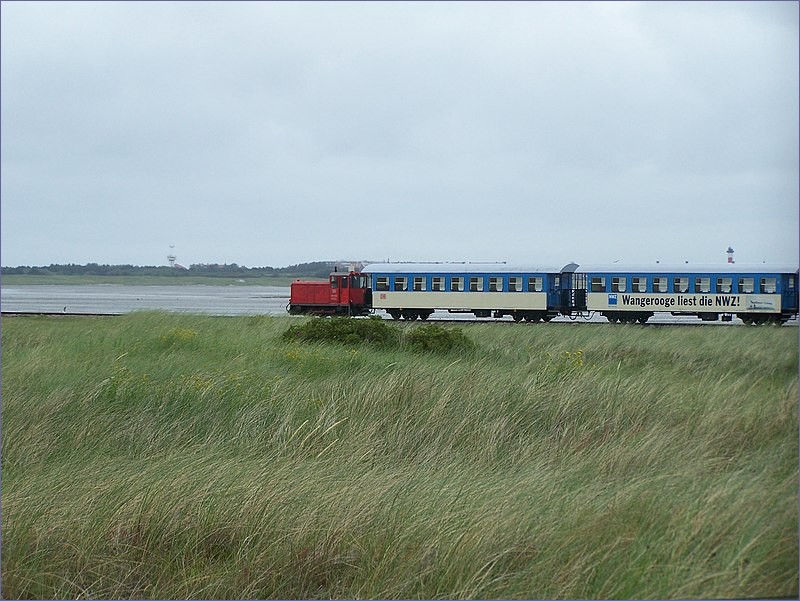Wangerooge is one of the East Frisian Islands in the North Sea located close to the coasts of the Netherlands, Germany and Denmark. The island is very popular among tourists due to the clean sandy beaches, various recreation facilities and its atmosphere. There is a short narrow gauge railway on the island. Trains on Wangerooge run from the harbor to the main village. It is the most important means of transport on the island and is the only narrow gauge railway operated today by the Deutsche Bahn.
Trains on Wangerooge are operated by Deutsche Bahn, but network tickets are not accepted. Trains have to sail through an area of mud flats, the timetable is dependent on the tide.
Wangerooge Island Railway – official website; train and ferry timetable
The Wangerooge Island Railway is the main means of transport on the island.
The island can be reached by ferry from the small port of Harlesiel. The cruise lasts 50 minutes, and passengers board the train straight after they disembark the ferry. The train ride takes about 30 minutes. Short flights are also available from Harlesiel to Wangarooge Island Airport.
There is no railway to Harlesiel. By train, you can get, for example, to Sande station, from which buses depart with connections to Osnabruck – Wilhelmshaven trains operated by NordWestBahn (in the NWB timetable), while Deutsche Bahn is responsible for the bus connection. The bus journey from Sande to Harlesiel takes approximately one and a half hours.
Trains on Wangerooge – history
The railway in Wangerooge was opened in 1897. The line was built to 1,000 mm gauge and initially operated by the Grand Duchy of Oldenburg State Railways (Großherzoglich Oldenburgische Eisenbahn or GOE). The line with a total length of 3.5 km led from pier in the southwest of the island to the center of the island village. Steam-hauled trains covered the distance in approximately 20 minute at top speed of 30 km/h.
In 1901 a 1.9 km branch was built from the Saline to the military base.
The Wangerooge Island Railway was opened in 1897 with its present-day track gauge of 1,000 mm (3 ft 3+3⁄8 in). Its operator was It was worked from the outset by steam locomotives, and not as a horse-drawn railway as on several neighbouring islands. The line led from the newly built pier in the southwest of the island to the middle of the island village, or Inseldorf, in the centre of the island. A train needed about 20 minutes to negotiate the 3.5 kilometre long route at a top speed of 30 km/h. These timings are still valid today, even though the route has been changed several times.
In 1901 a 1.9 kilometre long stub line was built from the Saline, the half-way point on the route towards the western part of the island in order to link the military base there.
In 1905 the line was extended from Inseldorf to the newly built East Pier.
In 1906 a new, large station was built on the southern edge of the village. The station has remained largely unchanged to the present day.
On 25 April 1945 an air raid destroyed the line between Saline and the village, the station hall and many passenger and goods wagons. After the end of the war the destroyed section was rebuilt.
In 1952 diesel locomotives were introduced by Deutsche Bahn.
Related articles:
Train travel in Germany
Trains on Langeoog
Trains on Borkum
Horse-drawn tram on Spiekeroog
